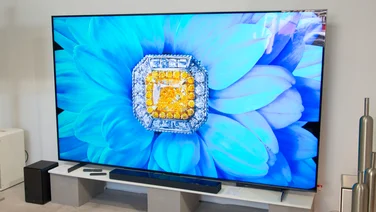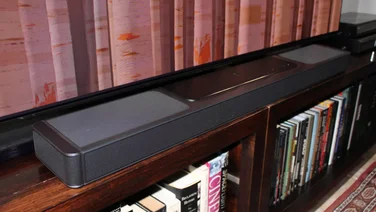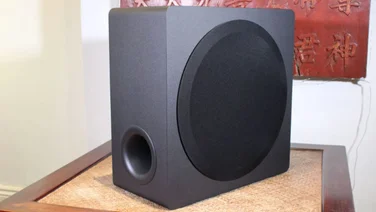To help us provide you with free impartial advice, we may earn a commission if you buy through links on our site. Learn more









Ever since an enterprising couch potato thought it would be a good idea to control a television from the sofa, rather than getting up to change the channel, TV remotes have pretty much stayed the same. Buttons are ideal for simple actions such as volume and power control, and the humble directional keypad makes short work of menus. However, the rise of Smart TV has changed all that.
Now that more and more TVs ship with web browsers, games and interactive applications, the humble remote control is beginning to show its limitations. There’s now more content available at your fingertips than you could possibly ever watch, but digging through menus or using virtual keyboards to search is slow and frustrating. Even something as simple as finding your favourite program on BBC iPlayer can involve going through four or five menu levels and entering text one letter at a time using a directional keypad.

TVs are becoming more like PCs, but the remotes are living in the past
It’s clearly time for a change, and each manufacturer has its own idea as to how best to do it, but so far no-one has really cracked it – at least not in our eyes. Novel new methods of interaction are rough around the edges and re-purposing ideas from other gadgets often misses the mark because they are unsuited to the sofa-based viewing experience.
THE PROBLEM
Samsung is particularly undecided, having taken something of a scattergun approach to its flagship ES8000 LCD TV this year. With two remote controls in the box, along with both voice and motion control, there was far too much choice for the average user, and it didn’t help that not one of these stood out as being really useful.
Its motion recognition boiled down to waving a hand and making a fist, which isn’t particularly suited to couch surfers, and the voice commands were basic, robotic statements that felt unnatural and were limited to specific actions. We imagine there was a lot of pressure internally to get the feature out, however well it actually worked; especially given the advertising possibilities it opened up.
We weren’t aware Benny Hill had a second career as a Samsung engineer
In theory, voice and motion control are ideal ways to interact with technology, but not in their current forms. Currently, voice-controlled TVs have a pre-programmed list of commands that must be uttered exactly in order to register a match. If the company hasn’t programmed an alternative phrasing, you’re limited to a single statement to perform simple actions that takes a mere button press on a traditional remote control. The limited degree of recognition accuracy also means that unless you speak with a BBC-trained English accent, there’s a good chance your command won’t get recognised even if you get the wording correct.
We’re beginning to see more natural speech recognition programs in smartphones, particularly Apple’s Siri and Android’s Google Now. However these upload your speech to a server, which then parses that into text before searching for an answer and returning it. That’s all well and good when you’re looking for “A good Indian restaurant nearby”, as you accept a greater delay in the response than when asking your TV for “BBC One”.
Until you can accurately search for the title of a foreign film using a thick regional accent, the kind of voice control promised throughout science fiction feels like a long way away. After all the Enterprise never had any problems with Scotty’s Scottish brogue.

Kinnect – motion control done right?
Effective motion control requires dedicated hardware and significant processing power, both things possessed by Xbox Kinnect but sorely lacking from all the TVs currently offering gesture recognition. Even at its best it is too dependent on sweeping arm-length gestures, which work best when stood up rather than crashed out on the sofa.
With such a long way to go for perfect voice and motion control, you would expect manufacturers to be concentrating on smaller issues, such as an effective way to control an on-screen cursor. LG’s Magic Motion remote is perhaps the most recognisable, and Panasonic has its own touchpad-based design, but neither are perfect.
As its name suggests, the Magic Motion looks more like something from the halls of a 21st century Hogwarts than a remote control. It’s thin, long and obscure-looking enough to confuse your grandparents, who just want to watch Diagnosis Murder but “can’t find the TV remote”.

LG Magic Motion – great for mouse control, but hopeless for text entry
With the Magic Motion, LG TV owners have fairly accurate mouse cursor control as long as they maintain a line of sight with the TV. Break the connection or point away from the set and you lose control, which can make selecting icons at the edge of the screen a particularly frustrating experience.

Panasonic touchpad remote – flawed by design?
Meanwhile, the Panasonic and Samsung touchpad remote designs are thwarted by the way we use remote controls. Unlike a laptop touchpad, which you control with a finger, you use your thumb to operate a TV remote. For the most part this shouldn’t be a problem, but you run into issues when scrolling upwards. This motion causes the point of touch to change from the tip to the ball of the thumb, confusing the remote and moving the cursor on-screen. This kind of inconsistency is irritating to the user, particularly when it happens a lot.

Sony’s first attempt at a smart TV remote was abysmal…
Sony had real trouble settling on a remote design for its first Google TV box, to the point that the European launch was delayed while a second controller was manufactured. The first, more traditional, remote had a physical keyboard that’s pretty much essential for interacting with Google’s TV interface, but it only had a directional keypad rather than any natural way to control a mouse cursor. The keyboard was also far too small, laid out in a grid that was unnatural to type on and had a lot of superfluous buttons that made it confusing to use.

…things improved with the second version, but it still had problems
The second attempt was an improvement, returning to a more traditional shape and moving the keyboard to the rear and disabling it using an accelerometer when it wasn’t required. However, the front-facing touchpad suffers from the same problem as Panasonic’s design – it simply can’t handle the changing touch points that occur when navigating using your thumb.
THE FUTURE
Having spotted where things can go wrong, we can now turn our attention to how to do it correctly. At this year’s IFA trade show in Berlin, we think we found one company that’s managed to do the impossible – create the first remote control ideally suited to the Smart TV age. Philips, the company behind it, is quietly proud of its design, but we think it’s easily the best TV remote we’ve come across.

From the front, it looks like any other remote control…
Shaped like any other remote control, there can’t be any confusion as to how it operates – all the standard buttons are there, with only a few more advanced functions grouped well out of reach of the simple directional keypad. At a glance it can be difficult to spot how it’s ideally suited for Smart TVs, but dig a little deeper and the answers are obvious.
First, it solves the problem of text entry. Simple solutions are often the best, and a physical keyboard is surely the simplest – it’s something everyone is already familiar with, so they already know how it works, with no need to learn voice commands or motion gestures. Flipping the remote over reveals a physical keyboard that negates the need for a virtual one.

…but flip it over and it’s perfect for text entry
The keyboard has been split into two sections – not to make room for the batteries, but to make it possible to type with both thumbs regardless of the size of your hands. Larger keys that stretched across the whole remote would have been less than comfortable for some and borderline unusable for others, but in this configuration anyone will be able to use it comfortably.
Flipping over the remote takes less than a second, but it wouldn’t be particularly useful if you accidentally pressed the buttons on the reverse every time you did it – one slip and you could turn off the TV during a crucial plot point or the closing seconds of the match. That’s why an integrated gravity sensor disables the side facing downwards, so you can grip tightly and not worry about accidentally changing channel or powering off the set.
It also deftly deals with cursor control. Taking its cues from the modern smartphone, the addition of accelerometers and gyroscopes let you naturally control an on-screen cursor without the need for a constant line of sight. Motions are recorded digitally, rather than optically, so they won’t feel as jerky as LG’s IR-emitting Magic Motion. With the right settings, cursor control should be fluid and natural.

This wouldn’t be very useful if the cursor moved every time you nudged the remote, so Philips has sensibly added a touch-sensitive button that only enabled cursor movement when it detects pressure. Picking the Ok button for this task makes perfect sense, as it’s the one you’ll be using to make selections, so you never have to think about it – your finger naturally gravitates there.
Is it the perfect remote control? No. From what we can see, the one downside is that the buttons aren’t backlit, so you might struggle to type out a message in the dark, but as you’ll be doing the most important actions with muscle memory rather than looking at the remote directly you shouldn’t struggle to change channel or power of the set.
THE END?
Based on what we’ve seen, we’re hoping that Philips has finally cracked the smart TV remote. Not so it can get a leg up on the competition, but so those other companies sit up and take notice, improve their own remotes and we finally get a straightforward, natural way to interact with our increasingly useful TVs. After all, why boot up your PC or laptop to send a tweet, if you can do it straight from the sofa?
Once a standard has been established, third party developers will know what can and can’t be done on a TV, which will hopefully lead to more services and features available for download in the future. If they want to turn their attention to more futuristic control methods, that’s great too – just as long as we don’t have to worry about how we’ll navigate BBC iPlayer in the meantime.






